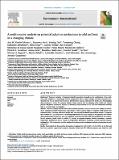Por favor, use este identificador para citar o enlazar a este item:
http://hdl.handle.net/10261/174215COMPARTIR / EXPORTAR:
 SHARE SHARE
 CORE
BASE CORE
BASE
|
|
| Visualizar otros formatos: MARC | Dublin Core | RDF | ORE | MODS | METS | DIDL | DATACITE | |

| Título: | A multi-country analysis on potential adaptive mechanisms to cold and heat in a changing climate |
Autor: | Vicedo-Cabrera, Ana Maria; Sera, Francesco; Tobías, Aurelio CSIC ORCID; Armstrong, Ben G.; Gasparrini, Antonio | Palabras clave: | Adaptation Climate change Hot Temperature Cold Heat Mortality |
Fecha de publicación: | feb-2018 | Editor: | Elsevier | Citación: | Environment International 111: 239-246 (2018) | Resumen: | Background Temporal variation of temperature-health associations depends on the combination of two pathways: pure adaptation to increasingly warmer temperatures due to climate change, and other attenuation mechanisms due to non-climate factors such as infrastructural changes and improved health care. Disentangling these pathways is critical for assessing climate change impacts and for planning public health and climate policies. We present evidence on this topic by assessing temporal trends in cold- and heat-attributable mortality risks in a multi-country investigation. Methods Trends in country-specific attributable mortality fractions (AFs) for cold and heat (defined as below/above minimum mortality temperature, respectively) in 305 locations within 10 countries (1985–2012) were estimated using a two-stage time-series design with time-varying distributed lag non-linear models. To separate the contribution of pure adaptation to increasing temperatures and active changes in susceptibility (non-climate driven mechanisms) to heat and cold, we compared observed yearly-AFs with those predicted in two counterfactual scenarios: trends driven by either (1) changes in exposure-response function (assuming a constant temperature distribution), (2) or changes in temperature distribution (assuming constant exposure-response relationships). This comparison provides insights about the potential mechanisms and pace of adaptation in each population. Results Heat-related AFs decreased in all countries (ranging from 0.45–1.66% to 0.15–0.93%, in the first and last 5-year periods, respectively) except in Australia, Ireland and UK. Different patterns were found for cold (where AFs ranged from 5.57–15.43% to 2.16–8.91%), showing either decreasing (Brazil, Japan, Spain, Australia and Ireland), increasing (USA), or stable trends (Canada, South Korea and UK). Heat-AF trends were mostly driven by changes in exposure-response associations due to modified susceptibility to temperature, whereas no clear patterns were observed for cold. Conclusions Our findings suggest a decrease in heat-mortality impacts over the past decades, well beyond those expected from a pure adaptation to changes in temperature due to the observed warming. This indicates that there is scope for the development of public health strategies to mitigate heat-related climate change impacts. In contrast, no clear conclusions were found for cold. Further investigations should focus on identification of factors defining these changes in susceptibility. © 2017 The Authors | Versión del editor: | https://doi.org/10.1016/j.envint.2017.11.006 | URI: | http://hdl.handle.net/10261/174215 | DOI: | 10.1016/j.envint.2017.11.006 |
| Aparece en las colecciones: | (IDAEA) Artículos |
Ficheros en este ítem:
| Fichero | Descripción | Tamaño | Formato | |
|---|---|---|---|---|
| A multi-country analysis on potential adaptive mechanisms to cold and heat in a changing climate.pdf | 675,28 kB | Adobe PDF |  Visualizar/Abrir |
CORE Recommender
SCOPUSTM
Citations
122
checked on 28-abr-2024
WEB OF SCIENCETM
Citations
116
checked on 20-feb-2024
Page view(s)
252
checked on 03-may-2024
Download(s)
221
checked on 03-may-2024
Google ScholarTM
Check
Altmetric
Altmetric
NOTA: Los ítems de Digital.CSIC están protegidos por copyright, con todos los derechos reservados, a menos que se indique lo contrario.


